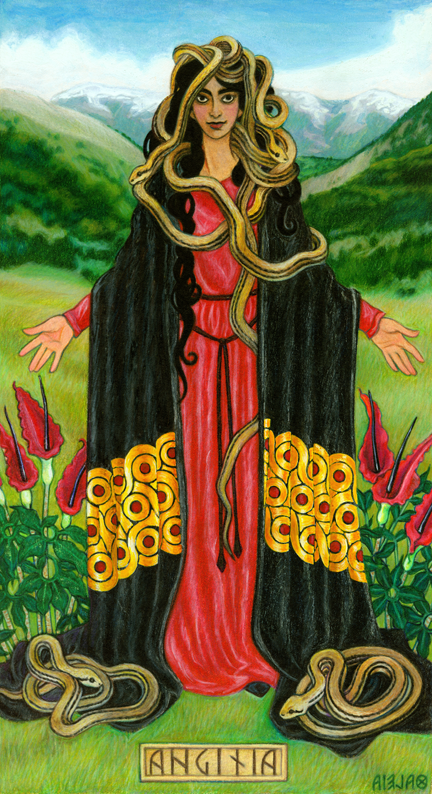 Angitia, watercolor pencil on board, shown draped with several four-lined ratsnakes in the manner of the statue of St. Domenico. Beside Her are Arum dracunculus plants, said by Pliny to be a cure for snake bite; the Marsian Hills are behind. 
Angitia (the Latin name of the Oscan Anagtia), is an Oscan healing and snake Goddess who was especially revered by the Marsi, a warlike tribe of people who lived to the east of Rome in the Apennine Mountains (sometimes called after them the Marsian Hills) and who spoke a Sabellan dialect. She was famed for Her ability to heal those who had been poisoned, especially those bitten by snakes, and She was said to have the power to kill serpents through spoken charms. The Marsi themselves shared in Her reputation as healers, magicians, and snake-charmers, and in fact to this day the Serpari, or snake-catchers of the area are held in high regard. In Rome of the 1st century CE, the Marsi were reputed to be healers and fortune-tellers, and their land was considered a hotbed of witchcraft. Angitia was famous for Her knowledge of healing herbs, and was honored with both a grove, the Silva Angitia or Lucus Angitiae, and a temple (complete with treasury) on the south western shores of Lake Fucinus. Fucinus was a large lake (more than 30 miles in circumference) that had no outlet and that was prone to overflow onto nearby towns after the spring rains, which may be why it was drained in the 19th century. Umbro, a legendary priest and seer of the Marsi, was said, like Angitia, to have been a snake-charmer and healer who could cure their bites; according to the Aeneid, Lake Fucinus was said to have wept for him when he was killed in battle. Angitia's name is believed to be derived either from angere, "to trouble", referring to Her ability to kill snakes, or anguis, "snake" or "serpent". Some inscriptions mention Angitia in the plural as a group, the Angitiae (much like Sulis and the Sulivae), and in one inscription, She is mentioned with Angerona, the Goddess of Silence and the Winter Solstice. According to Servius, Angitia was the name given to the witch Medea, who fled to Italy after her plot to poison Theseus was discovered. Medea is much associated with sorcery and serpents or dragons, and so she was identified with the native Marsian snake and magic Goddess. The modern Italian region of Abruzzo, roughly the homeland of the Marsi, is still associated with snakes, epitomized by the Feast of the Serpari. This feast is first mentioned in medieval times (though it is likely far older), and is celebrated in the village of Cocullo (population 316!) on the first Thursday in May. The Serpari are a hereditary brotherhood of snake-charmers who play a major role in the festival. Sometime around the first day of spring, the Serpari gather the local snakes (mostly the four-lined ratsnake, a large, though calm-mannered species that is not poisonous), and bring them back to the village, where their fangs are removed. They are then kept in wooden boxes or terracotta jars until the festival and treated well. On the day of the festival, pilgrims gather in the church of San Domenico to be healed, for, like Angitia, the Saint is believed to have healing powers, especially in the curing of snake bites, rabid dog bites, and toothaches. After Mass, the statue of the Saint is carried from the church in a procession and draped with live snakes, followed by the Serpari and others of the faithful, also draped with serpents. In earlier tradition, the snakes were then killed and eaten in a feast, but now bread is substituted, formed into various snakey shapes--some in the form of twined snakes; others made as interlocking rings of snakes, biting their tails, ouroboros-like; or made in serpent-form with sliced-almond scales and coffee bean eyes! Nowadays they are not killed, but released back into the wild when the festival is over. And by the way, snakes are continually growing new teeth, and will replace lost fangs in as little as a week, depending on the species. Alternate names/spellings: Angizia, Anagtia, Anagtia Diiva, Anguitia, Anguitina, Angitia; Anceta, a Paelignian Healing Goddess is probably the same name in the Paelignian dialect. The Bona Dea of Rome is almost certainly the same Goddess, and it is noteworthy that Her festival is in early May, just like St. Domenico's. Angitia was also associated with the Greek sorceress Kirke or Circe. |
|
|



